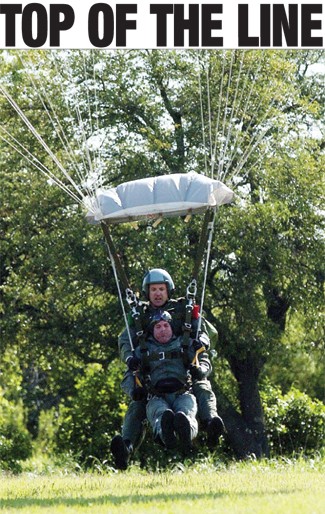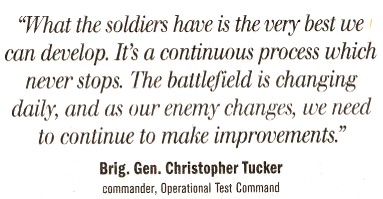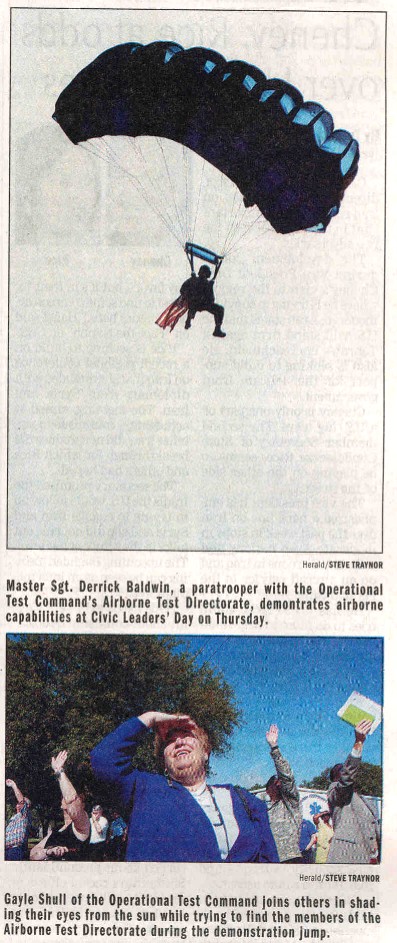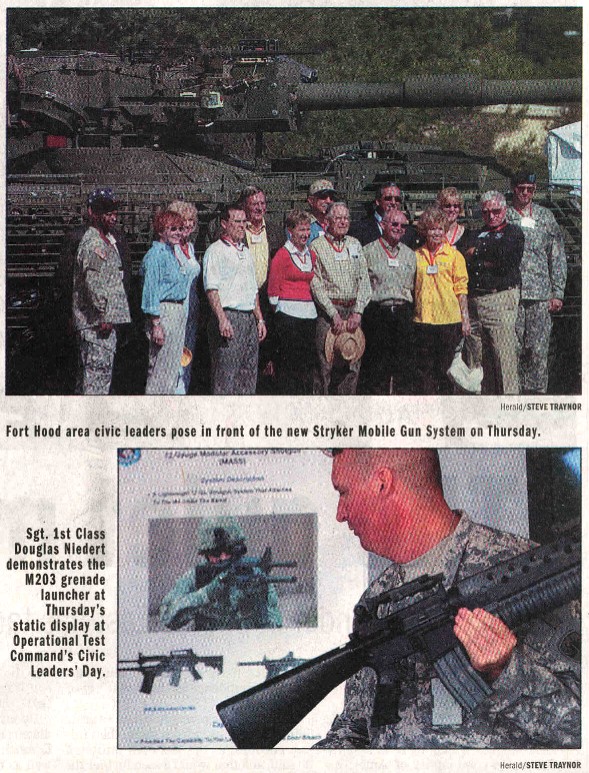|
 OTC
certifies new gear for Soldiers OTC
certifies new gear for Soldiers
By James David
Fighting a war on two
fronts puts lots of stress on soldiers and their
equipment. Modifications and new weapons and equipment
are always being tested and fielded. To that end, the
soldiers and civilians assigned to West Fort Hood's
Operational Test Command are hard at work testing new
vehicles and systems for the soldiers and Marines in the
field in the war on terror.
The OTC is the Army's independent operational tester,
and answers only to its customers – American soldiers.
Brig. Gen. Christopher Tucker, the OTC commander,
explained the relationship that the OTC has with the
Army at its annual OTC Civic Leaders' Day Thursday at
West Fort Hood.
"Our independence means that we answer directly to the
Army's senior leadership," Tucker said. "The soldiers in
the field rely on us to make an accurate assessment of
new systems. In order to do that we have to go where the
soldiers go.
"Right now, we have 23 soldiers and six civilians in
Iraq and Afghanistan."
"I've got folks from Baghdad to Balad" in Iraq, Tucker
said.
The Operational Test Command is one of three units that
comprise the Army Test and Evaluation Command. The other
two commands are Developmental Test Command, based out
of Aberdeen Proving Ground in Maryland and the U.S. Army
Evaluation Center, which is based in Alexandria, Va.

The soldiers and civilians who go to the war front are
known as Forward Operational Assessment teams.
Their mission as defined by the OTC is to collect data
on critical systems used by the war fighter.
"The people here care about the soldiers," Tucker said
at Thursday morning's briefing. I don't know another
organization in the Army quite like ours."
Some of the systems being analyzed by the FOA teams
include the new Mine Resistant Ambush Protected
Vehicles. On Thursday, the Army announced plans to seek
funding for 18,000 MRAPS, the same number of Humvees
currently in use in Iraq. Roadside bombs are the largest
killer of soldiers and Marines in Iraq. The Marine Corps
has ordered 3,700 of the vehicles.
In a USA Today story published on April 19, the Marine
Corps reported that there have been more than 300
attacks on their MRAPS in Iraq, but that no Marines had
been killed as a result. Defense Secretary Robert Gates
said in Wednesday's Pentagon press conference that he
will phase out the use of all Humvees in Iraq and
Afghanistan for the newer vehicles.
 "The
safety of our soldiers is OTC's top priority," Tucker
said. "The MRAP program is our highest priority at this
juncture, because 70 percent of all our casualties in
Iraq are (roadside bomb) related." "The
safety of our soldiers is OTC's top priority," Tucker
said. "The MRAP program is our highest priority at this
juncture, because 70 percent of all our casualties in
Iraq are (roadside bomb) related."
The FOA teams rotate to Iraq and Afghanistan every six
months and have a two-part mission. The first is to test
new equipment at the operational level; the second is to
be a liaison between the soldiers in the field and the
institutional side of the Army. They also advise the
soldiers in the field on how to best maintain and employ
their equipment.
Other projects being assessed by the teams include the
command post of the future, Countering Rockets,
Artillery and Mortars, the Cougar fighting vehicle, the
Mechanical Anti-Personnel Mine Clearing System, The Body
Ventilation System and the Warlock system, which is
designed to jam mobile phone signals used to detonate
bombs.
"What the soldiers have is the very best we can
develop," Tucker said. "It's a continuous process which
never stops. The battlefield is changing daily, and as
our enemy changes, we need to continue to make
improvements."
One example of how the test command reacts rapidly to
changing threats is the armor kits to upgrade the
Humvees in Iraq. Maj. Mike Fitzgerald is a testing
officer at the command. He showed the leaders in
attendance the developments being made in fragmentation
protection kits from the war's inception to now.
"From the time we were made aware of the higher
lethality of the Roadside bombs being produced, it took
us 54 days to develop and get 1,000 of the newer armored
kits into Iraq." Fitzgerald said. "Now, every vehicle
that rolls out of the FOB (forward operating bases) has
the highest level of protection available," he said.
The added protection has a price. The newer kits add so
much weight to the Humvees that it affects their speed
and performance. Fitzgerald said that you can never have
enough armor on the Humvees, but the MRAP vehicle will
greatly improve soldier survivability.
Enhancements also are being made in indirect fire
weapons such as field artillery. Lt. Col. Courtney
Blackwell works for the Test command as the chief of
Fort Sill's Fire Support Test Directorate and was on
hand Thursday to brief leaders on the newest
enhancements to artillery, including the Excalibur
artillery round and Multiple Launched Rocket Systems
improvements.
The Excalibur replaces the Copperhead, which was a
laser-guided shell. Excalibur relies on the technology
of the satellite based global positioning system (GPS)
and is more accurate than its predescessor.
"We were able to get it into Iraq after only two months
of testing," Blackwell said. "In fact, it was used in a
fire mission for the first time in Iraq just last week."
The Stryker units are getting a new version of the
Mobile Gun System (MGS). It consists of a 105-millimeter
cannon mounted on a Stryker chassis. Designed for close
direct-fire support to the Stryker units, it has a
three-man crew and will complement the other nine
variations of the Stryker family of vehicles. Tucker
said he has sent 29 of the vehicles to Iraq and they are
being evaluated by their test command teams.

Improvements are also being made in communication
devices. The voice response translator and the IBM
automatic speech translator allow the soldier to
communicate to foreign nationals without the use of an
interpreter. The IBM version is a laptop allowing
two-way speech interpretation.
Lt. Gen. Stephen Speakes, The Army's deputy chief for
programs, spoke at the culmination of Thursday's events,
a dinner and awards presentation at Fort Hood's Catering
and Conference Center. He addressed the changing face of
the battlefield and the future of the Army engaged in
the war on terror.
Speakes was the primary crafter of the Army's new model
of deploying to war in modular brigade combat teams.
"OTC is now a mobile command," Speakes said. "We can't
conduct business like we used to, taking 20 years to get
new equipment to the soldiers."
Speakes said the Army is going through a hard time. The
war in Iraq is highly unpopular and public opinion
drives the funding of the war and the Army, he said.
"Unfortunately, there is not a commitment among many in
our country to source the military," he said. "That's
where I come in. I don't believe we are where we need to
be right now." Speakes said, referring to the level of
funding or equipment in the total force, active duty,
National Guard and Reserve.
"Soldiers will always be occupied doing something in the
world, even after we leave Iraq, so I have to ensure we
get an adequate level of funding," Speakes said.
With regard to the Mine Resistant Ambush Protected
Vehicle program, Speakes said that both he and the
Defense Secretary Robert Gates are committed to bringing
the vehicles to the soldiers in record time.
"The timetable is this summer or early fall," Speakes
said. "Walter Reed was a wake-up call for the Army.
"Our soldiers deserve only the best. Getting the MRAP
out there to the battlefield is a soldier care issue as
much as health care is."
Speakes said innovations such as utilizing robots to
check out an area rather than exposing soldiers to the
hazards of roadside bombs and snipers are being looked
at for immediate implementation.
"The days of a squad being stacked on the side of a
building are going to come to an end," he said,
referring to robotics. "We have robotics now to assess
the situation."
 |